1993 BUICK REGAL ESP
[x] Cancel search: ESPPage 6 of 308
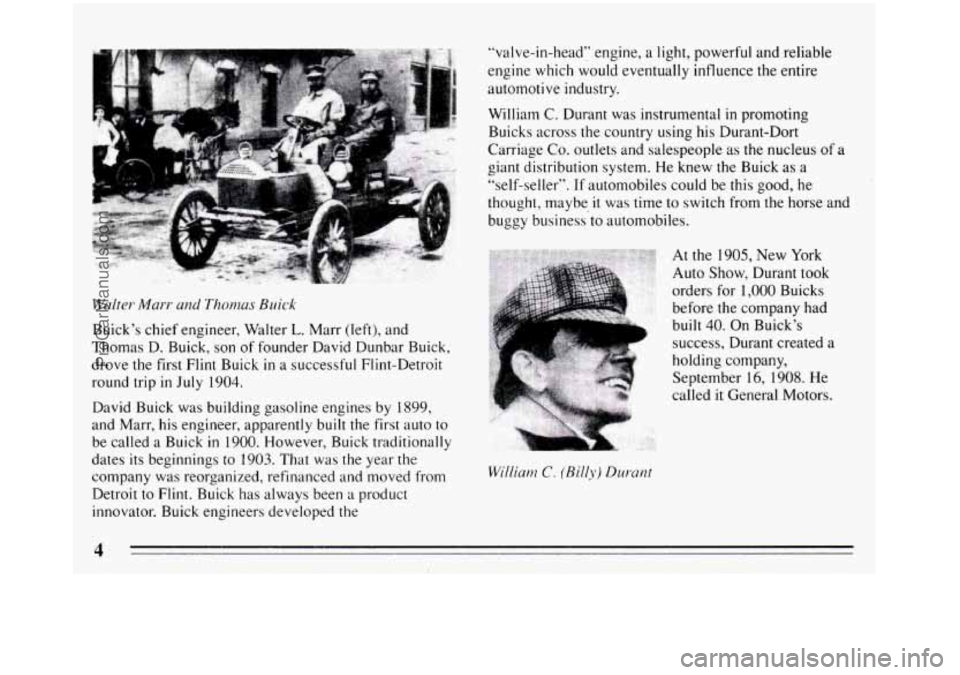
Walter Marr and Thomas Buick
Buick’s chief engineer, Walter L. Marr (left), and
Thomas D. Buick, son of founder David Dunbar Buick,
drove the first Flint Buick in a successful Flint-Detroit
round trip
in July 1904.
David Buick was building gasoline engines by 1899,
and Marr, his engineer, apparently built the first auto to
be called a Buick in 1900. However, Buick traditionally
dates its beginnings to 1903. That was the year the
company was reorganized, refinanced and moved from
Detroit to Flint. Buick has always been a product
innovator. Buick engineers developed the “valve-in-head”
engine, a light, powerful and reliable
engine which would eventually influence the entire
automotive industry.
William
C. Durant was instrumental in promoting
Buicks across the country using his Durant-Dort
Carriage
Co. outlets and salespeople as the nucleus of a
giant distribution system. He
knew the Buick as a
“self-seller”. If automobiles could be this good, he
thought, maybe it was time to switch from the horse and
buggy business.to automobiles.
Willianz C. (Billy) Durant
4
ProCarManuals.com
Page 27 of 308
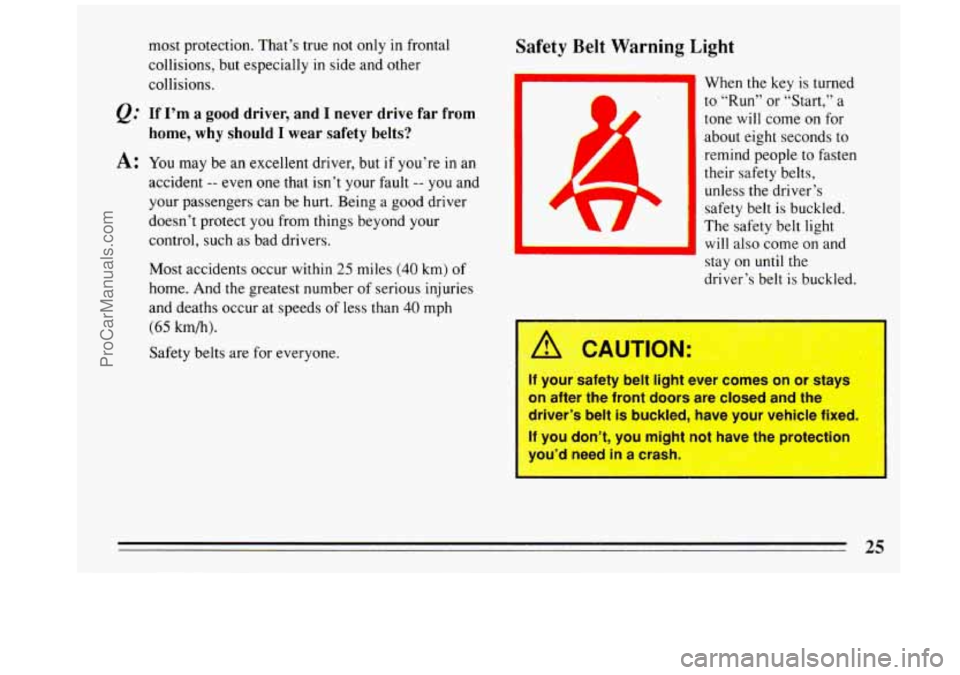
most protection. That’s true not only in frontal
collisions, but especially in side and other
collisions.
Q.’ If I’m a good driver, and I never drive far from
home, why should
I wear safety belts?
A: You may be an excellent driver, but if you’re in an
accident -- even one that isn’t your fault -- you and
your passengers can be hurt. Being a good driver
doesn’t protect you from things beyond your
control, such as bad drivers.
Most accidents occur within
25 miles (40 km) of
home. And the greatest number of serious injuries
and deaths occur at speeds of less than
40 mph
(65 km/h).
Safety belts are for everyone.
Safety Belt Warning Eight
L J When the key is turned
to “Run” or “Start,” a
tone will come
on for
about eight seconds to
remind people
to fasten
their safety belts, unless the driver’s
safety belt
is buckled.
The safety belt light
I I will also come on and
stay on
until the
driver’s belt is buckled.
I
A CAUTION:
If your safety belt light ever comes on or stays
on after the front doors are closed and the
driver’s belt
is buckled, have your vehicle fixed.
I If you don’t, you might not have the Drotection
you’d need in a crash.
I I
25
ProCarManuals.com
Page 61 of 308
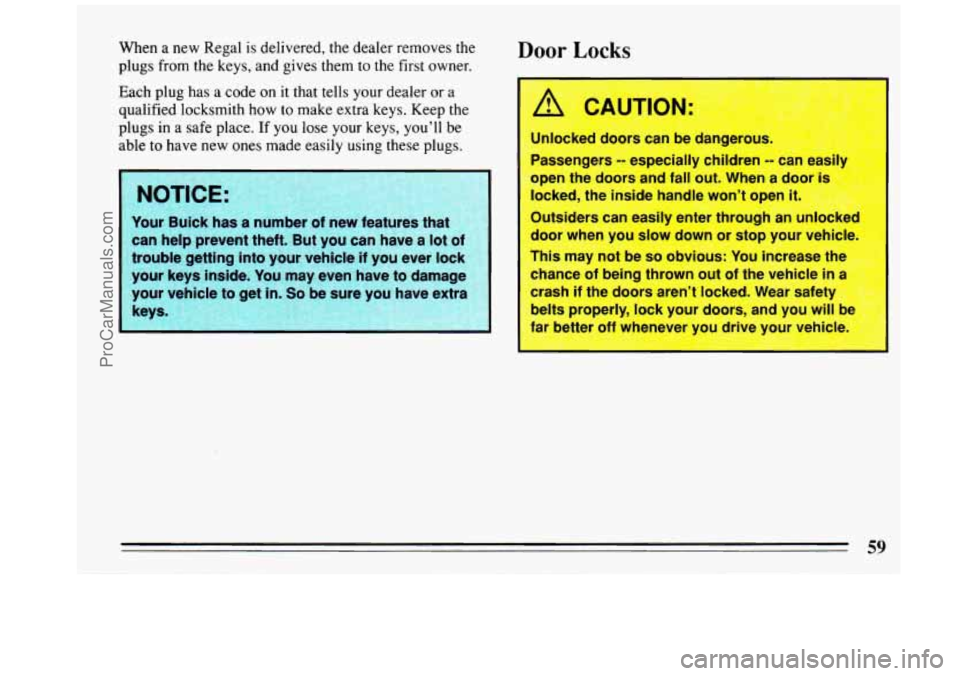
When a new Regal is delivered, the dealer removes the
plugs from the keys, and gives them to
the first owner.
Each plug has a code on it that tells your dealer
or a
qualified locksmith how to make extra keys. Keep the
plugs in
a safe place. If you lose your keys, you’ll be
able
to have new ones made easily using these plugs.
Your Buick has a number of new features that &$$
can help prevent theft. But you can have a lot of @
trouble getting into your vehicle if you ever lock E:+ g;:
your keys inside. You may even have to damage
your v
keys.
.i ’ 0 I- 7
&?
Door Locks
I
A CAUTIuN:
Unlocked doors can be dangerous.
Passengers
-- especially children -- can easily
open the doors and fall out. When a door is
‘-:ked, the inside handle won’t open
if
Outsiders can easily enter through an unlock€
This may not be
so obvious: You increase the
chance of being thrown out of the vehicle
in a
ash if the doors aren’t locked. Wear safety
belts properly, lock your doors, and you will be
far better off whenever you drive your vehicle.
)or
when you slow down or stop your vehicle.
59
ProCarManuals.com
Page 66 of 308
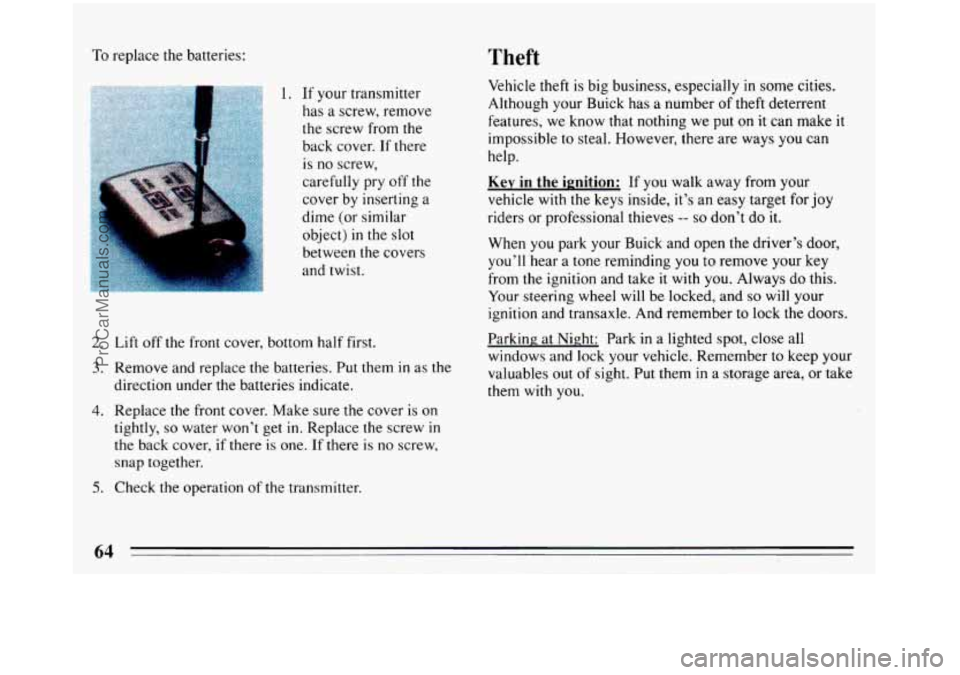
To replace the batteries: Theft
1. If your transmitter
has
a screw, remove
the screw from the
back cover.
If there
is no screw,
carefully pry off the
cover by inserting a
dime (or similar
object)
in the slot
between the covers
and twist.
2. Lift off the front cover, bottom half first.
3. Remove and replace the batteries. Put them in as the
direction under the batteries indicate.
4. Replace the front cover. Make sure the cover is on
tightly, so water won’t get in. Replace the screw in
the back cover, if there is one. If there is no screw,
snap together.
5. Check the operation of the transmitter. Vehicle
theft is big business, especially in some cities.
Although your Buick has a number of theft deterrent
features, we know that nothing we put on
it can make it
impossible
to steal. However, there are ways you can
help.
Key in the ignition: If you walk away from your
vehicle with the keys inside, it’s
an easy target for joy
riders or professional thieves
-- so don’t do it.
When you park your Buick and open the driver’s door,
you’ll hear a tone reminding you to remove your key
from the ignition and take it with you. Always do this.
Your steering wheel will be locked, and
so will your
ignition and transaxle. And remember to lock
the doors.
Parking at
Night: Park in a lighted spot, close all
windows and
lock your vehicle. Remember to keep your
valuables
out of sight. Put them in a storage area, or take
them with
you.
64
ProCarManuals.com
Page 84 of 308

To signal a turn, move the lever all the way up or down.
When the turn
is finished, the lever will return
automatically.
A green arrow on the
instrument panel will flash in the direction of the turn
or lane change.
To signal a lane change, just raise or lower the lever
until the green arrow starts to flash. Hold it there
until
you complete your lane change. The lever will return by
itself when
you release it.
As you signal a turn or a lane change, if the arrows don’t
flash but just stay
on, a signal bulb may be burned out
and other drivers won’t see your
turn signal. If
a bulb
is burned out, replace it to help avoid an
accident. If the green arrows don’t
go on at all when you
signal a turn, check the fuse (see “Fuses” in the Index)
and for burned-out bulbs.
Turn Signal “ON” Chime
A chime will sound if your turn signal is left on after
having gone
3/4 mile, to remind you to turn your signal
off.
Operation of Lights
Although your vehicle’s lighting system (headlights,
parking lights, fog lamps, side marker lights and
taillights) meet
all applicable federal lighting
requirements, certain states and provinces may apply
their own lighting regulations that may require special
attention before you operate these lights. For example,
some jurisdictions may require that you operate your
lower beam lights with fog lamps at all times, or that
headlights be turned on whenever you must use your
windshield wipers. In addition,
most jurisdictions
prohibit driving solely with parking lights, especially at
dawn or dusk. It is recommended that you check with
you own state or provincial highway authority for
applicable lighting regulations.
82
-
ProCarManuals.com
Page 115 of 308
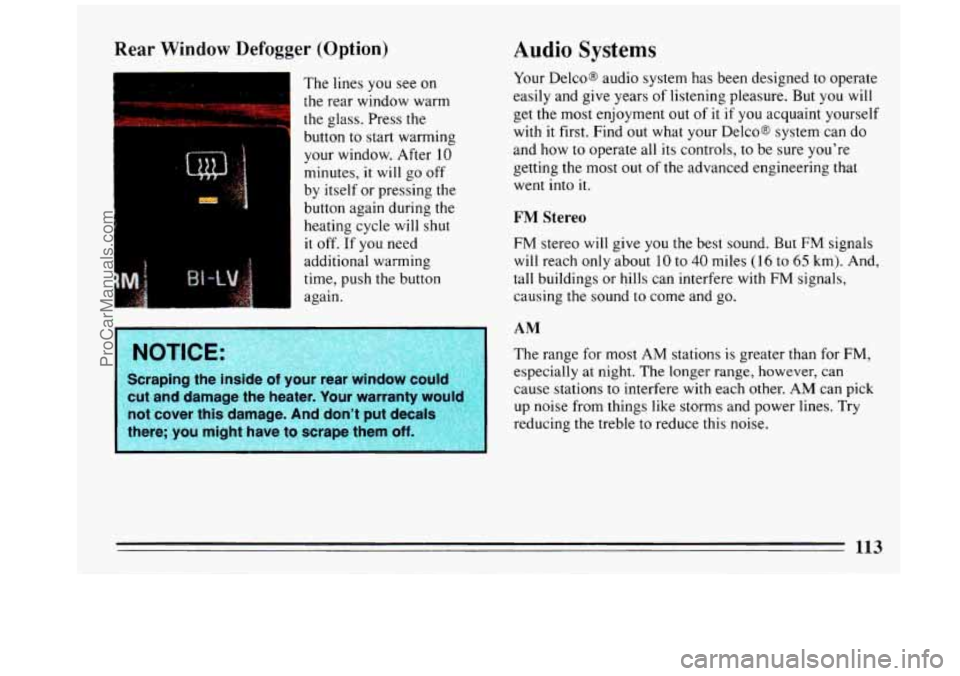
Rear Window Defogger (Option)
b
I -c
1 The lines you see on
I the rear window warm
the glass. Press the
button to start warming
your window. After
10
minutes, it will go off
by itself or pressing the
button again during the
heating cycle will shut
it
off. If you need
additional warming
time, push the button
again.
NOTICE:
Scraping the inside of your rear window could
cut and damage the heater. Your warranty would
not cover this damage.
And don’t plat decals
there; you might have to scrape them
off.
Audio Systems
Your Delcom audio system has been designed to operate
easily and give years of listening pleasure.
But you will
get the most enjoyment out
of it if you acquaint yourself
with it first. Find out what your Delcoa system can do
and how to operate all its controls, to be sure you’re
getting the most
out of the advanced engineering that
went into it.
FM Stereo
FM stereo will give you the best sound. But FM signals
will reach only about 10 to 40 miles (16 to 65 km). And,
tall buildings or hills can interfere with FM signals,
causing the sound
to come and go.
AM
The range for most AM stations is greater than for FM,
especially at night. The longer range, however, can
cause stations to interfere with each other. AM can pick
up noise from things like storms and power lines. Try
reducing the treble to reduce this noise.
113
ProCarManuals.com
Page 122 of 308

Scan
Press the SCAN button to hear each station for a few
seconds. Push it again to stop scanning.
Pushbuttons
The five buttons can be used to preset ten radio stations
(5 AM and 5 FM stations.)
0
0
0
0
Tune in the desired station.
Press SET. (The SET indicator will appear on the
screen for five seconds.)
While the
SET indicator is displayed, press one of
the five buttons. Whenever you press that button
again,
the preset station will return.
Repeat these steps for each
of 5 AM and 5 FM
stations.
Loud
Press LD to increase the bass response.
Mute
Pressing Mute allows you to silence the radio or tape
player; press again to listen. During mute, only volume
up works.
Clock
With the ignition on and the radio off, press SET. The
set indicator will appear on the display for five seconds.
During that five seconds, press SCAN to set the
0 Press SET again. Within 5 seconds, press SEEK to
minute.
set the hour.
To Play A Cassette Player
To turn the system on, the radio power must be on. The
radio will play until a cassette is pushed into the cassette
entry door
(the tape side goes in first). Do not use tapes
that are longer than
92 minutes (46 minutes on each
side.)
120
___ ~ -
ProCarManuals.com
Page 140 of 308
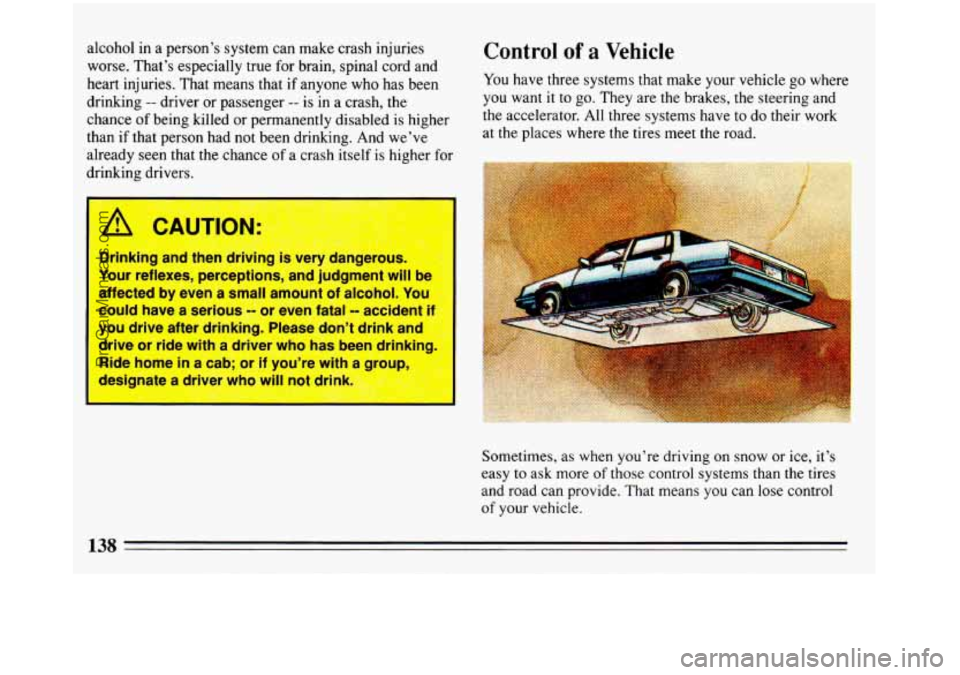
alcohol in a person’s system can make crash injuries
worse. That’s especially true for brain, spinal cord and
heart injuries. That means that if anyone who has been
drinking
-- driver or passenger -- is in a crash, the
chance of being killed or permanently disabled is higher
than if that person had not been drinking. And we’ve
already seen that the chance
of a crash itself is higher for
drinking drivers.
I A CAUTION:
Drinking and then driving is very dangerous.
Your reflexes, perceptions, and judgment will be
affected by even
a small amount of alcohol. You
~ could have a serious -- or even fatal -- accident if
you drive after drinking. Please don’t drink and
drive or ride with a driver who has been drinking.
Ride home
in a cab; or if you’re with a group,
designate a driver who will not drink:.
Control of a Vehicle
You have three systems that make your vehicle go where
you want it to
go. They are the brakes, the steering and
the accelerator. All three systems have to do their work
at the places where the tires meet the road.
Sometimes, as when you’re driving on snow or ice, it’s
easy to ask more
of those control systems than the tires
and road can provide. That means you can lose control
of your vehicle.
138
ProCarManuals.com